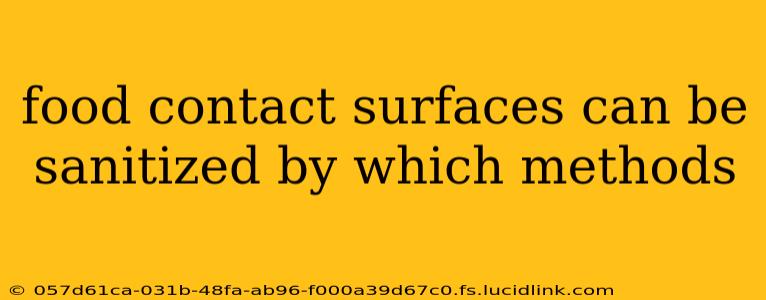Maintaining the hygiene of food contact surfaces is paramount in preventing foodborne illnesses. Improper sanitation can lead to contamination, posing serious health risks. This comprehensive guide explores various effective sanitizing methods for food contact surfaces, addressing common questions and concerns.
What are Food Contact Surfaces?
Before diving into sanitization methods, let's define what constitutes a food contact surface. These are any surfaces that come into direct contact with food during preparation, processing, storage, or service. This includes, but isn't limited to:
- Equipment: Cutting boards, knives, slicers, meat grinders, mixing bowls, utensils, countertops, food preparation tables.
- Utensils: Spoons, forks, knives, ladles, spatulas.
- Containers: Storage containers, packaging materials.
- Servingware: Plates, cups, glasses.
How Can I Sanitize Food Contact Surfaces?
Effective sanitization requires a two-step process: cleaning followed by sanitizing. Cleaning removes visible soil and food residue, while sanitizing reduces the number of microorganisms to safe levels. Several methods effectively sanitize food contact surfaces:
1. Heat Sanitization
Heat is a highly effective sanitizing method, particularly for utensils and smaller equipment. This can be achieved through:
- Hot water: Immersing cleaned items in water at least 171°F (77°C) for at least 30 seconds effectively kills most harmful bacteria. This is often used for dishwashing.
- Steam: Steam sanitizers are commonly used in commercial kitchens to sanitize utensils and equipment. High-temperature steam rapidly kills microorganisms.
2. Chemical Sanitization
Chemical sanitizers are widely used for a variety of food contact surfaces. Common chemical sanitizers include:
- Chlorine: A widely available and effective sanitizer, but it's crucial to use the correct concentration (typically 50-200 ppm) and contact time (at least 30 seconds). Always follow manufacturer instructions carefully.
- Iodine: Another effective chemical sanitizer, iodine solutions require proper dilution and contact time.
- Quaternary ammonium compounds (quats): Quats are effective against a broad spectrum of microorganisms. However, they may not be effective against all types of bacteria, and their effectiveness can be impacted by the presence of organic matter.
3. Ozone Sanitization
Ozone sanitization is a newer method gaining traction. It utilizes ozone gas (O3) to kill microorganisms. Ozone is a powerful oxidizer, effectively destroying bacteria, viruses, and molds. This method is often used for larger equipment and facilities.
What are the Different Types of Sanitizing Solutions?
Various sanitizing solutions are available, each with its own strengths and weaknesses. The choice of sanitizer depends on the specific application, the type of surface, and the level of contamination. Understanding the differences is crucial for selecting the right product:
- Chlorine bleach solutions: Affordable and widely available but require careful dilution to prevent damage to surfaces and ensure effectiveness.
- Iodine solutions: Effective against a broad range of microorganisms, but the concentration needs to be carefully monitored.
- Quaternary ammonium compounds (quats): Often less corrosive than chlorine and iodine but might not be as effective against all types of bacteria.
- Acid sanitizers: Effective against certain types of bacteria, but less effective against others.
How Often Should I Sanitize Food Contact Surfaces?
The frequency of sanitization depends on several factors, including the type of food being handled, the level of contamination risk, and the frequency of use. However, as a general rule, food contact surfaces should be sanitized:
- After each use: This is especially important for surfaces that come into contact with raw meat, poultry, or seafood.
- Between different food types: To prevent cross-contamination.
- At least once a day: Even if the surfaces appear clean, daily sanitization helps maintain hygiene.
What are the Best Practices for Sanitizing Food Contact Surfaces?
Following best practices ensures effective sanitization and minimizes the risk of foodborne illnesses. These best practices include:
- Pre-cleaning: Always clean surfaces thoroughly before sanitizing.
- Proper dilution: Always follow the manufacturer's instructions for diluting chemical sanitizers.
- Contact time: Ensure adequate contact time between the sanitizer and the surface.
- Temperature: Maintain the correct water temperature for hot water sanitization.
- Rinsing: Rinse all surfaces thoroughly after sanitization to remove any sanitizer residue.
- Proper storage: Store sanitizing solutions according to the manufacturer's instructions.
By diligently following these guidelines and choosing appropriate sanitization methods, you can significantly reduce the risk of foodborne illnesses and maintain the highest standards of food safety. Remember, consistent sanitation is key to protecting public health.
